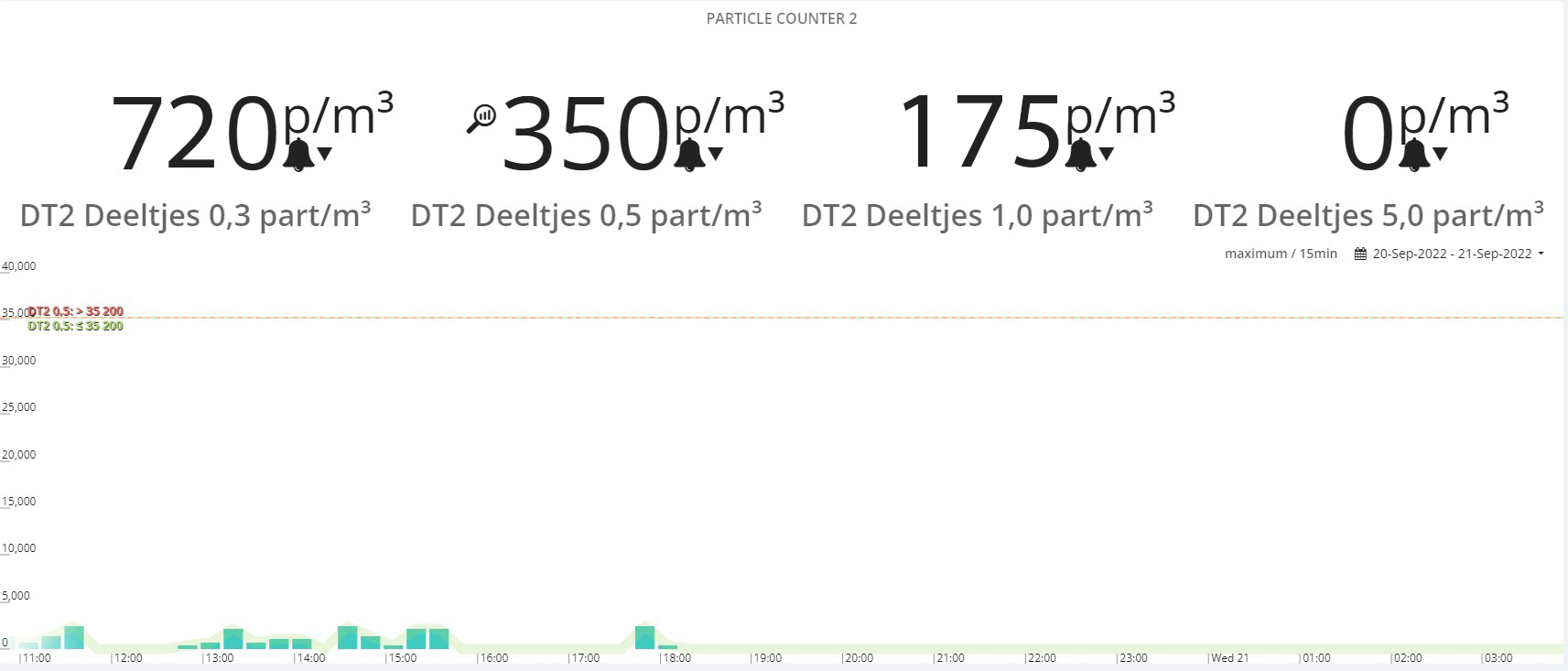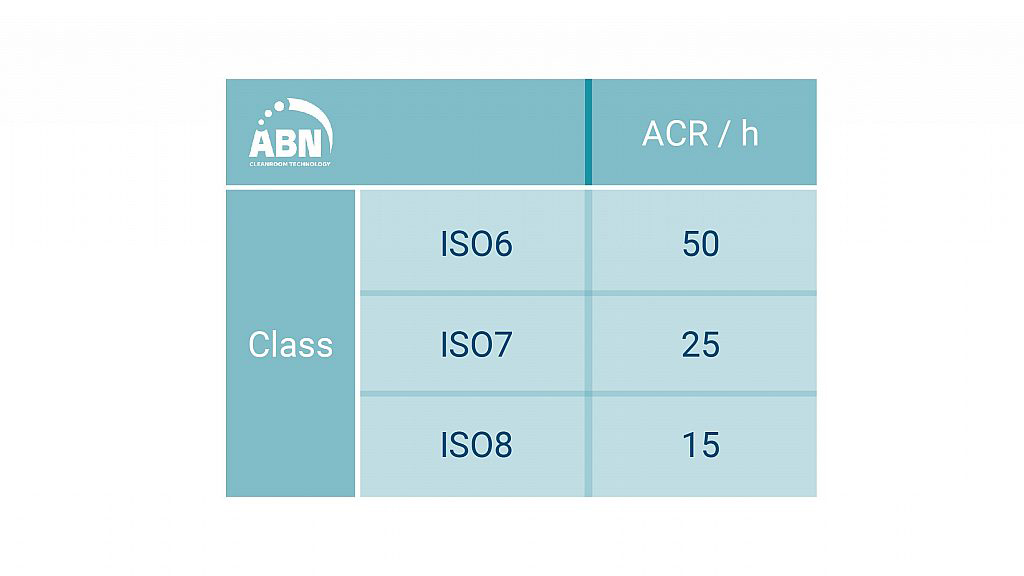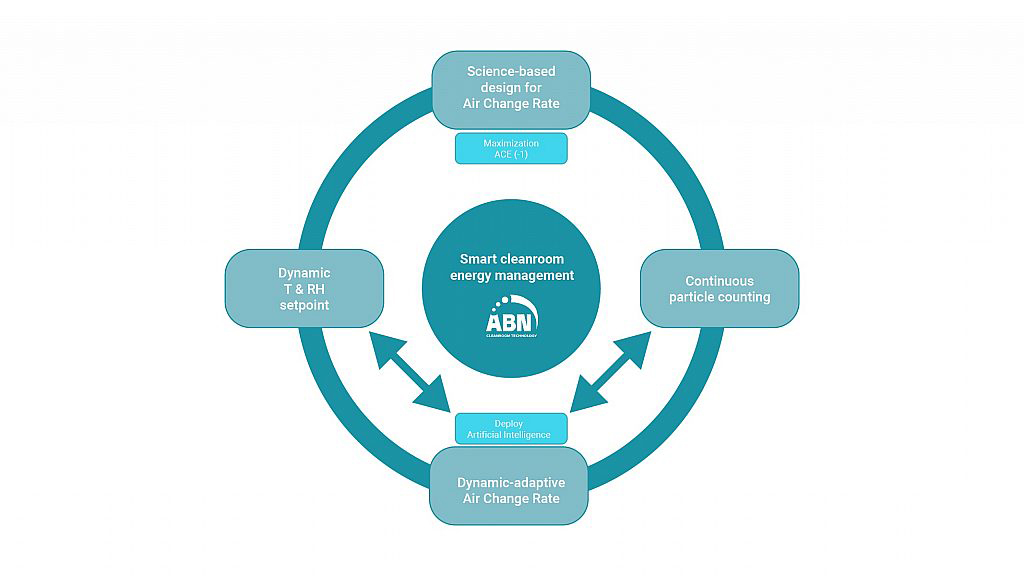As a result of rising energy prices, we notice that many cGMP and non-cGMP companies are considering installing a continuous particle counter in their cleanroom. Since continuous particle counting within cGMP is only a requirement in Grade B and Grade A environments, it didn’t happen often in other cleanroom environments until today. Companies are finding that the investment cost of an online particle counting system pays for itself very quickly and opt for this interesting investment. A shift in the cleanroom world that is fully in line with our patented VIX concept and which we therefore completely approve.
Air Change Rate takes a big bite out of energy consumption
The predetermined Air Change Rates (ACR) needed to achieve a certain classification are usually drawn up from rules of thumb and assumptions.
As can be seen in the table below, it has been established that the air in an ISO Class 6 environment must be purged no less than 50 times per hour. From our expertise, we find that these values have been built in with far too much certainty.
A major flaw, for example, is that it does not consider variable factors per specific cleanroom, such as the number of operators and their clothing protocols, the contamination of machines, or the processes taking place in the cleanroom. This often creates an overkill in terms of air changes, which will result in unnecessarily high energy consumption.
By integrating a continuous particle counter, real-time integer data on contamination inside the cleanroom can be extracted. Based on this data, it can be determined how many air changes are needed to achieve certain cleanliness classifications.
If we see high values, this often means that there is something wrong with the clothing procedures
Regulating energy consumption based on particle counting
Energy savings is currently a hot topic at every company operating a cleanroom, no doubt for that. As a result of our patented VIX concept, we can configure our cleanrooms in various ways, allowing savings to be made in different manners:
Saving 1
As already indicated, we see that the particle level in many of our cleanrooms is often "too good" for the requirements of the critical environment. In other words, the ISO rating that is achieved is too high. The VIX concept allows us to lower the Air Change Rate at any time. This makes it possible, for example, to set a day regime (e.g.: 35 ACR) and night regime (e.g.: 15 ACR). Based on this information, we can decide if we go one step further in lowering the ACR. The main advantage about VIX is that the actions above have no impact on the pressure cascade that was envisaged in advance. The entire VIX system operates without any pressure as a result of energy-efficient EC fans on the extraction side that operate stepless without pre-pressure. This is in contrast to VAV-valves that always require pre-pressure and cannot be controlled steplessly. Not to mention the disruptive flow noise of a VAV-valve and the time delay between control and action.
Saving 2
Maintaining the relative humidity inside the cleanroom takes a big bite out of its energy consumption as well. Whereas humidification is required in winter, more dry air will need to be blown through the cleanroom in summer. The VIX concept allows us to switch off the RH when there is no production, so no humidity control is active. Moreover, we can always shift the RH limits within production time based on the actual status in the cleanroom.

Developing a cleanroom ecodesign by using AI
Continuous monitoring of a critical environment requires constant particle sampling. In this method, data is collected continuously so that events are not being missed. Sampling intervals can be of any duration, but shorter sampling intervals give better temporal resolution. Short intervals also provide huge amounts of data that can feed the system. Typical time intervals range from one minute to 15 minutes.
Continuous particle counting not only gives insight into whether we are doing things right, but also whether we have the cleaning and disinfection procedure under control. In practice, if we see high values, this often means that there is something wrong with the clothing procedures of the people inside the cleanroom. Large particles (>1µm) often originate from the clothing of operators inside the cleanroom. Together with our knowledge partner ALSICO, we are currently working on a study from which the correct clothing requirements per specific cleanroom can be derived.

Another important factor in this is the ACE, or the local Air Change Effectiveness. The ACE is determined by good mixing of the pulse air on one hand and the number of take-back points at floor level on the other. At ABN Cleanroom Technology, we always aim to have an ACE of around 1, which means that the required pulse flow rate is minimal. We will discuss the ACE in more detail in a subsequent article.
By using artificial intelligence, we can perform pattern detection. For instance, we could uncover the differences between cleanroom conditions before and after cleaning processes. Or check which clothes and clothing procedures are the least polluting. By collecting and comparing all this data, we get a profound insight into the co-relation of different physical parameters. Moreover, we can always give operators and technicians immediate feedback when established procedures are not followed. By using sensors and sensor points, we can always check whether the agreed changing procedures in the Personnel Airlock are being followed correctly. All these solutions can be easily integrated into your 21 CFR Part 11 workflow.

The platform that allows the above-mentioned is GMPconnect. A CFR21 Part 11 compliant cloud platform that collects and maintains integer online data. This data allows us to maintain our risk-based management vision. From our own experience, we can state that a continuous particle counter is a good investment. The savings it delivers in terms of energy consumption alone pay for themselves in no time at all.
Moreover, it always gives cleanroom users the most accurate insights into the processes in their cleanroom, from which an enormous amount of valuable information can also be extracted.
